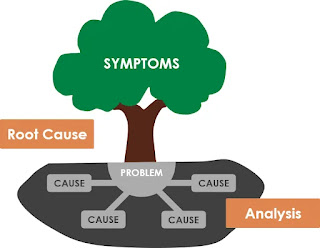How To Manage Risk As An Entrepreneur
One of the tools that can be deployed is Root
Cause Analysis. This is a structured problem-solving approach that aims to identify
the fundamental reasons behind an issue or problem by breaking down the system
to address the causes of an issue as opposed to finding a solution to an issue.
In order to do this first the user must identify
and understand the problem, knowing what you are trying to fix greatly
enhances your ability to provide the correct diagnosis later on.
Then one must break down the event into causes
and symptoms. Causes refer to the underlying reason behind the issue, whilst
symptoms are the visible effects of the problem. This is important as “only
treating the symptoms runs the risk of getting sick again”
Now once the cause has been identified one
can now address the cause of the issues/risk. By understanding the root cause,
one can now take direct action to address it. Tackling the root cause basically
allows for the prevention of similar situations in the future.
In summary, Root Cause Analysis breaks down
issues into a simple and logical format, allowing for a more effective and long
term response to help mitigate and reduce risk.
References
Brown, L. (31 December, 2023). Top 8 Risk
Management Tools and Techniques in [2024]. Retrieved 5 April, 2024, from
Invensis:
https://www.invensislearning.com/blog/risk-management-tools-techniques-in-pm/
Davis, J. (10 Aprl, 2024). How to implement root cause
analysis (RCA): Explanation and examples. Retrieved 11 April, 2024, from
eputra: https://eptura.com/discover-more/blog/root-cause-analysis/
Gerge, T. (7 January, 2023). What Is Root Cause Analysis?
| Definition & Examples. Retrieved 5 April, 2024, from Scribbr:
https://www.scribbr.co.uk/the-research-process/the-root-cause-analysis/
Kost, E. (18 January, 2024). How-To Guide: Digital Risk
Managment for Businesses. Retrieved 4 April, 2024, from UpGuard:
https://www.upguard.com/blog/digital-risk-management
Visual Paradigm. (n.d.). How to use 5 Whys Tree
Diagram for Root Cause Analysis? Retrieved 11 April, 2024, from Visual
Paradigm:
https://online.visual-paradigm.com/knowledge/root-cause-analysis/how-to-use-five-whys-tree-diagram/
Badr Abduldaim - TP074644
I am going to introduce you to risk management which involves making risky decisions to achieve certain goals trying to succeed in the competitive business world, we must make sure that the risk we take as an enterprise is worth or will have some value upon taking. Taking a risk is not always a bad move, it emphasizes the strategic planning and critical thinking in the company.
"We don't manage risks so we can have no risk. We manage risks so we know which risks are worth taking, which ones will get us to our goal, which ones have enough of a payout to even take them," Forrester.(Linda Tucci,2023)
"The pandemic is a great example of a risk issue that is very easy to ignore if you don't take a holistic, long-term strategic view of the kinds of risks that could hurt you as a company," Shinkman said. "A lot of companies will look back and say, 'You know, we should have known about this, or at least thought about the financial implications of something like this before it happened.'"(Linda Tucci,2023)
references:
Linda,T. (2023). what is risk management and why is it important from :TargetTech
https://www.techtarget.com/searchsecurity/definition/What-is-risk-management-and-why-is-it-important
Abdirahman
Warsame
Figure
1: How to manage risks.
Part of being an entrepreneur is to take
risks, there are many ways of taking risks but one crucial one is by conducting
a risk assessment.
Conducting a risk assessment is an
important step in the risk management process for entrepreneurs. It entails
assessing the likelihood and severity of potential risks to your business. A
risk assessment allows you to identify the areas of your business that are most
vulnerable and prioritise your risk management efforts.
There are several approaches to conducting
a risk assessment, including brainstorming sessions, SWOT analysis, and
decision trees.
The key is to take a systematic approach
that addresses all aspects of your business and takes into account both
internal and external factors. During a risk assessment, you will consider each
risk's potential impact on your business, including financial, operational,
legal, market, and reputational implications. A comprehensive risk assessment
allows you to identify the risks that pose the greatest threat to your business
and create a plan to effectively mitigate or manage them.
References
Contentfy, A. (24 March, 2024). How
to manage risk as an entrepreneur. Retrieved from aicontefy:
https://aicontentfy.com/en/blog/how-to-manage-risk-as-entrepreneur




Comments
Post a Comment